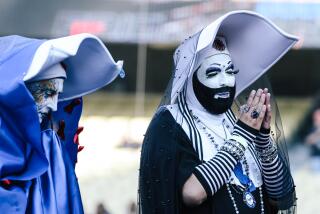Sororities and Fraternities : ‘In’ Groups in Again, but Underground
Lisa Drollinger entered high school with a choice facing many sophomores in Long Beach public schools: Which sorority should she join?
It was an easy decision for Lisa, now a 17-year-old who will graduate from Poly High School this spring. She wanted to become a member of Poly’s “in” crowd.
“Since ninth grade, everyone knew I wanted to pledge Scarabs,” she said, mentioning one of the more popular clubs.
Fraternities and sororities, once respected parts of the educational system here, were banned from campus in the early 1960s, when the civil rights movement moved the state to prohibit the use of public funds on groups with exclusive memberships. Today they operate clandestinely, with limited membership and secret initiation rites, yet they continue to be as important as graduation to many teen-agers in tradition-rich Long Beach.
The clubs date from the 1930s, when a group of Poly athletes began socializing once a week after school. That club, Comas, still exists. Its membership, like other clubs in the city’s schools, has been passed down from senior to sophomore, sibling to sibling, sometimes parent to child. Even today, minority membership is minimal.
‘Exclusive Groups’
“The clubs have no standards for membership. They are exclusive groups,” said Ed Eveland, assistant superintendent for secondary schools. Eveland has been a principal at three Long Beach high schools and is considered an unofficial historian of the prep fraternities.
A year or two after the clubs were banned from the campuses they became “a real headache,” Eveland said. Because they reorganized outside the school system, the district was powerless to discipline them. Devoid of adult supervision, club members took a bolder attitude on campus, often disrupting school activities and conducting initiation periods known as “Hell Weeks” on school grounds.
In the 1940s and ‘50s, group pictures of club members routinely appeared in school yearbooks in the city’s five high schools. The clubs provided volunteers for school projects.
At Wilson, their legacy is reflected in the school-sponsored club, Zygomas. It was created in 1957, when 20 members of several sororities got together for a school charity project.
“We were nice girls,” said Janie Carey, 48, who was a member of Phi Gamma Chi when she joined that first group of Z-girls. “Only scags, hoods and squares didn’t belong to a group.”
“The majority of the clubs were very much interested in service to their school,” Eveland said. “It’s a shame that we were forced” to bar the clubs, he said.
But Eveland, whose daughter belonged to Ami at Wilson, acknowledges that recent club activities “are alienating people.”
Karen McGrew, an assistant principal at Millikan High and also the activities director at Wilson High in the 1970s, said the district does not recognize the clubs as legitimate organizations.
Lisa Drollinger and her friends do not understand the district’s get-tough approach. Lisa said she received detention this year for wearing a Scarabs sweat shirt to class. She said other club members have been disciplined for conducting club activities on school grounds, a charge that was supported by Poly Vice Principal Linda Moore.
“The students received disciplinary action for conducting hazing activities on campus,” Moore said.
Lisa said the clubs are misunderstood.
“To the police and the schools, we’re just another gang,” she said. “That’s not true.”
The district’s hard line against groups it once coddled has also angered Lisa’s mother.
“Scarabs has been a very positive experience for my daughter,” Sandra Drollinger said. “It does not interfere academically. I’ve never had a bad experience with these kids.”
Painting of Insignia
Senior members paint their club’s insignia on the street in front of a new member’s house. Specific streets have been singled out as favorite targets, although city officials take a dim view of that. A street-painting party near Los Cerritos Elementary School recently was broken up by police. Several students were cited and forced to pay the costs of resurfacing the street.
At Blair Field, across from Wilson High, the asphalt is covered with names like Aces, Athos, Lambda Phi and Ming.
The school district’s main concern today is hazing, although bizarre initiation rites have been part of the tradition from the beginning.
“When I pledged, the seniors rubbed Vaseline in my hair and made me swallow oysters on a string,” Carey said.
Yet, old-timers like Eveland still hold a spot in their heart for the clubs.
“They are sure a better way to go than street gangs,” he said.
More to Read
Sign up for Essential California
The most important California stories and recommendations in your inbox every morning.
You may occasionally receive promotional content from the Los Angeles Times.










